Introduction
Geophysics is one of the best tools to identify hydrocarbons in the absence of well control. Recently, the Securities and Exchange Commission (SEC) has allowed the use of “Reliable Technology” in reserve estimation for disclosure purposes. Therefore, the use of new technologies presents a significant opportunity for geophysics to become more widely used in reserves estimation. Geophysics also plays a significant role in unconventional reservoir development. Appraisal of unconventional reservoirs often makes use of technology and analysis closely related to contemporary geophysical work. As a result, there is an opportunity to increase the importance of geophysics in our businesses.
For geophysics to become a business tool, we must start thinking like our companies’ executive, stockholders and other business stakeholders. Geophysicists need to create information that is relevant and suitable for business decisions. This means going beyond amplitude and structure maps and embracing new tools that allow for the quantification of relevant information from the geophysical data in terms that everyone understands, such as improved drilling success rates and economic uplift. It is critical to quantify the economic value of geophysical information.
I have experienced this applied business model first-hand when in 2004, the Government of Alberta reviewed ways to improve conventional oil recovery. They were considering funding new techniques and technologies. All relevant methods, including seismic, were considered. I became involved and found many technical research papers suggesting geophysics improved the ability to find hydrocarbons, however the related statistics or economic impact was only rarely reported. This is particularly true for advanced seismic technologies like multi-component, depth migration, AVO and inversion. Even for 3D seismic, only a limited amount of information of this kind exists, despite widely accepted claims that it improves drilling success. One exception is that there is a significant amount of information on the economic benefits of 4D seismic. The lack of documentation quantifying the benefit of geophysical techniques hinders our discipline from confirming its economic importance. We need to produce proof of the value of geophysical methods like those written for 4D seismic. In 2004, when I, a geophysicist, did my study for the Alberta Government, I was unable to demonstrate to them that properly applied geophysical techniques and technology can improve conventional oil recovery. Geophysics can have a significant impact on our companies’ economic valuations through reducing uncertainty in resource and reserve appraisals, especially during early field development. In order to improve the economic relevance of geophysics, we must quantitatively demonstrate the economics of the geophysical technologies we use. I believe that economic impact of geophysical technologies and related success rates has not been adequately demonstrated for use in economic arguments for geophysical analysis. It is essential that we publish our analysis showing the economic benefit of the application of our technologies. This paper provides information from the 2004 study.
3D Seismic
Originally deployed commercially in the early 1980’s, 3D seismic started to make a significant impact on drilling success that was widely recognized by the early 1990’s, e.g. Aylor (1998). Now 3D seismic is being used increasingly in reservoir characterization to provide information between the wells [Cole et al., 2003].
The seismic response is a function of the total compressibility of the rock-fluid system in the reservoir; therefore, more compressible gas and lighter oils typically have greater seismic response in more compressible rocks, e.g. Tertiary sandstones. In incompressible rocks, e.g. carbonates, the seismic tends to respond to lithology, fractures and porosity. Estimates of the seismic response can be generated from the Gassmann equations [Mavko et al., 1998]. Unexpectedly low seismic velocities can be used to detect reservoir overpressure. This is effective in clastic environments where the sonic velocities of shales follow a consistent depth trend e.g. Mukerji et al., (2002); Hawkins et al., (2004). Increased porosity is evidenced by a decrease in amplitude in the seismic reflection at the top of the porous zone compared to laterally equivalent facies for both carbonates and clastics. Trappe and Krajewski (1996) show good results for porosity greater than 8%. This relationship should hold true for all porosities, but is affected by averaging over the length of the seismic wave.
A few publications do exist which quantify the impact of 3D seismic data. The limited number of these surprised me, since I have typically understood that the economic impact of 3D seismic data is well understood. Key comments from these publications are listed below.
3D Quantified Impact
- The average Amoco exploration 3D survey reliably condemns 1.4 of the average 3.4 previously defined prospects per 3D seismic survey, and discovers 2 new, previously unknown prospects per survey [Aylor, 1998]
- Amoco drilling overall success rate from 1990-1996 with 3D was 49%, whereas without 3D it was 14%. Worldwide, the industry average success rate is 18% [Aylor, 1998]
- Probability of drilling a successful exploration well is 48% with 3D [Allison and Transtrum, 1999]
- Probability of drilling a successful well is 80% with 3D [INEXS, 2004]
- Probability of drilling a successful exploration well is greater than 50% with 3D [Méndez-Hernández, 2003]
- Probability of drilling a successful well is 70% with 3D, 30- 35% without 3D [Nissen et al., 2003]
- Prior to the initiation of the NDP DOE Project, the proved producing recovery was estimated to be 1.9 MMBO and 5.23 BCFG, or 2.75 million BOE. Today we estimate the field will ultimately recover on the order of 5.3 million BOE, an increase of almost 200%. The 3-D seismic and horizontal drilling techniques have been the major contributors to this increase [Murphy, 2006]
The message derived from these publications is that the use of 3D seismic at least doubles the probability of drilling successful wells. Specifically, in the above articles, the probability of drilling a successful well when 3D seismic is used is 48-80%, which can be compared to 14-35% without 3D for combined exploration and development results. The higher rates (70-80%) likely reflect development and the lower (48-50%), exploration. Results will be better in softer sediments with softer fluids, such as the Colony gas sands, and worse in harder rocks with heavier oils, such as the Leduc-Nisku heavy oil play of the Williston Basin region of Southern Alberta, with a whole range of results in between.
4D or Time-Lapse Seismic
Developed during the 1990’s as a way to help understand the movement of fluids in producing reservoirs, 4D seismic implements multiple 3D seismic surveys in the same location but separated in time (the 4th dimension) to image changes, usually fluid saturation or pressure changes, in the reservoir. It has proven extremely successful for indicating bypassed oil in the right kind of reservoirs and has also driven the use of seismic in the field of geomechanics.
4D seismic data is being increasingly used to identify fluid movement, compartments, infill locations, bypassed oil and gas, and optimize development well placement. It is in regular use in the North Sea oil fields and the technology is beginning to be exported to other basins, including those of Canada’s oilsands undergoing SAGD and most recently, shale reservoirs.
There are a significant number of articles that address the economic impact of 4D seismic. This may be because it is more frequently used in reservoir development scenarios or brought in when there are production issues that are affecting the cost or development of the reservoir. This is the kind of information that we would like to see available in the public domain for all geophysical technologies. Listed below is some key information that I was able to find on the economic impact of 4D seismic.
4D Quantified Impact
- Incremental Recovery of 3-7% [Landmark, 2003]
- "Benefits from 4D technology can be in the tens or hundreds of millions of dollars. A significant fraction of these come from 4D surprises…” [de Waal and Calvert, 2003]
- “On the basis of the quality and detail of reservoir information from the pilot study, a multidisciplinary asset team assessed the economic feasibility of large-scale 4D monitoring of the Duri field. The assessment took into account the benefits of time-lapse seismic as well as the cost of seismic data and the risk probability of various outcomes. Benefits included shutting off injection in swept zones; putting steam into cold zones; and, locating observation wells in the right places, possibly eventually reducing the need for them. When these benefits were weighed vs. seismic-data cost and risk factors and compared with other operating scenarios for the field, the conclusion was that the largest net present value could be obtained by aggressively managing the steamflood with 4D seismic.” [JPT Online, 1999]
- BP/Shell’s Foenhaven Field off the western Shetlands, BP reports an expected increase in recovery from 40-50% of oil-inplace with conventional 3D to 65-75% with 4D [He et al., 1996]
- Pickering and Waggoner (2003) quantify 4D in several ways, both for individual surveys and for expectations for the 4D method as a whole.
- “A conservative figure puts the contribution from 4D seismic techniques at 50% of the value for the mentioned targets, which is equivalent to $US60-70 million” [Najjar et al., 2003]
- The key to 4D success is to plan the [multiple 3D seismic] surveys – and survey timing – so that the results have a significant impact on reservoir management [Marsh et al., 2003]
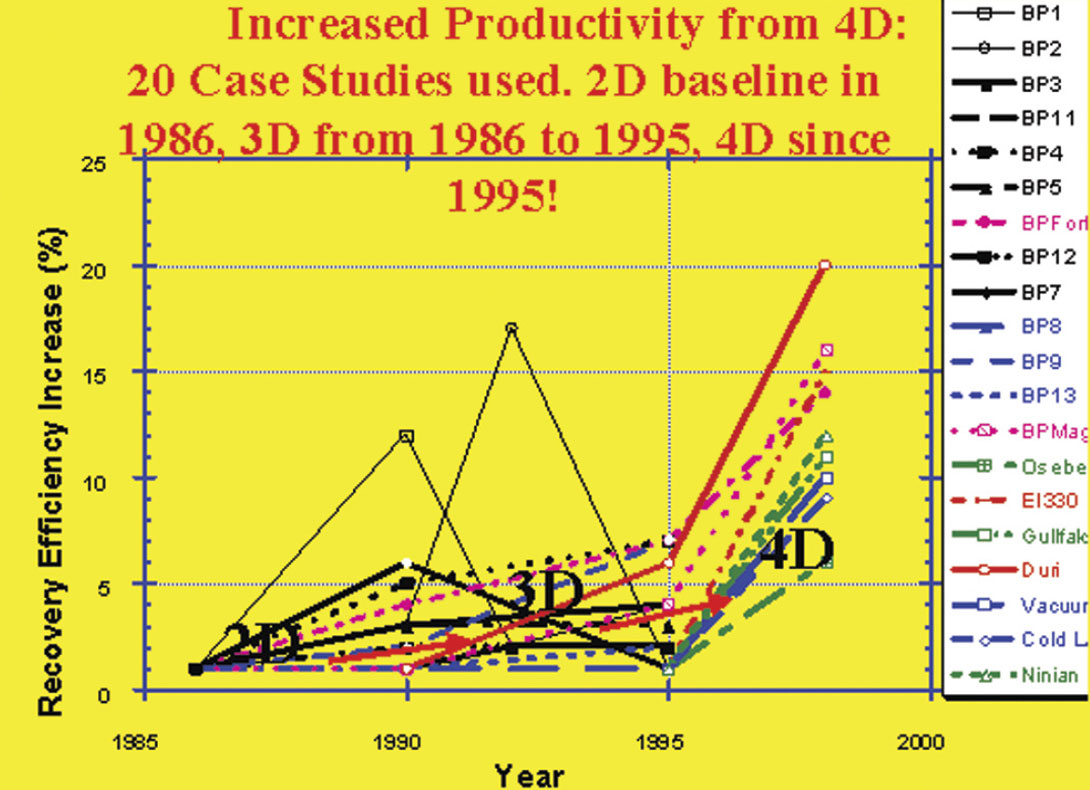
AVO
AVO or Amplitude Versus Offset analysis was discovered during the 1980’s. This technique helps to detect fluids through the variation in amplitude across offset of a seismic gather. Amplitudes on the near offset traces relative to the far offset traces decrease differently (i.e. negative amplitudes become more negative and positive amplitudes less positive) due to the presence of gas instead of brine in a compressible reservoir. AVO has proven extremely successful for indicating gas and light oils in the right kind of reservoirs. More recent developments include lithology identification, fracture detection and stress estimation.
AVO is being increasingly used to identify hydrocarbons and will prove to be very helpful as we move to deeper reservoirs, socalled class 1 and class 2 AVO plays, which are produced by reservoirs that are more difficult to distinguish in the seismic stack. AVO has played an important role in finding many of the stratigraphic traps that have been discovered recently. It is in regular use in the Gulf of Mexico and other Tertiary basins and the technology is beginning to be used in older basins, including Canada’s oilsands, the North Sea, e.g. [Tonn, 2007] and North American shale plays.
There is almost no information on the economic impact of the use of AVO. Anecdotal evidence suggests that success rates using AVO approximately double the success rates of conventional exploration techniques. The numbers that have been reported showed an increase in success rates from about 40% to about 80%. Gray and Todorovic-Marinic report that azimuthal AVO has a success rate of 70%. More recent work by the author has shown that success rates for their methods of fracture detection, which have expanded to include a combination of discontinuity attributes and azimuthal AVO, e.g. [Gray et al., 2003], can be quantified as about 80% for clastic reservoirs and about 60% for carbonate reservoirs based on about 40 test cases.
Seismic Reservoir Characterization
Seismic reservoir characterization can mean many things, ranging from amplitude analysis, to AVO, to full-blown prediction of reservoir properties. There is very little documentation on its success rate. According to Schlumberger (2004), “The project was completed two months ahead of schedule. The operator reduced drilling time 45% and drilling costs 30%.”
Microseismic – Passive Borehole Seismic Monitoring
The use of microseismic has grown leaps and bounds in conjunction with its use in hydraulic fracture modeling. There are many success stories that have been recorded since 2004. This is one technology where there is certainly some scope for quantifying its impact based on recent results. While doing research for the Alberta Government in 2004, there was little information on its quantitative impact.
Other Technologies
I was unable to find any information on the economic success rates of advanced seismic technologies. We must, in particular, improve the reporting of these numbers for these technologies. Geophysical technologies for which I was unable to find any publications on their quantitative impact in 2004 are:
- Depth migration
- Multi-component seismic
- Seismic amplitude inversion
- Seismic reservoir characterization
- Seismic attributes
- Other geophysical technologies
I encourage any of you who have information on the success rates or economic impact of any of these technologies to publish this information either as a paper or in letters to the editor. I believe that this information will have a significant impact on our ability to use geophysics for reservoir evaluation and thereby on the value of geophysics as a whole.
Literature
A literature search on the SEG (Society of Exploration Geophysicists) digital cumulative index and on OnePetro for only SPE (Society of Petroleum Engineers) papers produces the distribution of papers shown in Figure 2 for combinations of the following two sets of terms: {Engineering, Seismic, Geophysics} and {Economic, Success}. Relative values within each chart give an idea of the scope of the problem. Geophysicists consider the economic impact of their technology less than half as frequently as engineers when we write for publications.
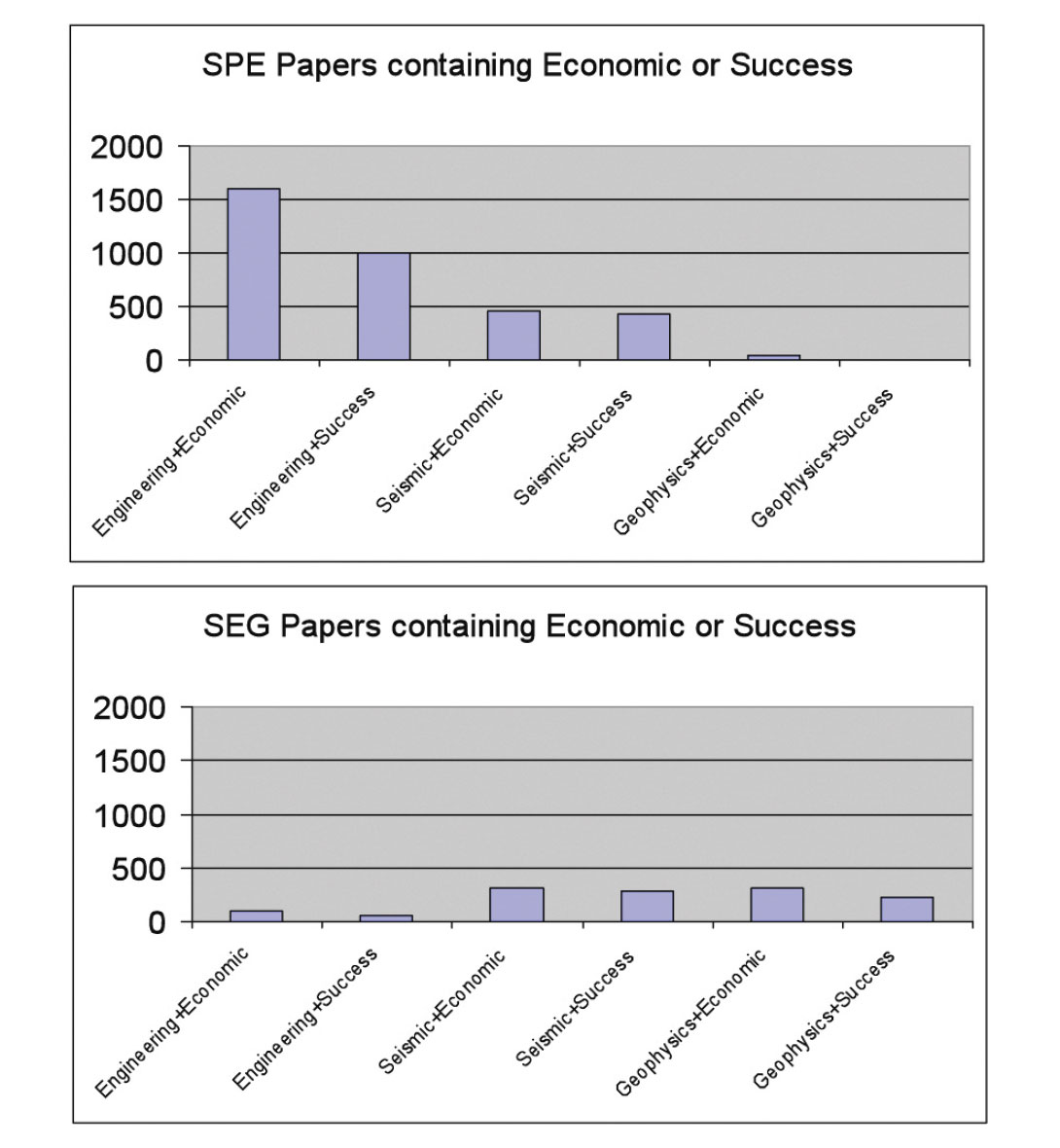
Conclusions
The SEC’s regulations now allow reliable technologies in reserve assessment, and as a consequence there is a considerable opportunity to improve the businesses importance of geophysics. In order to do this, we must demonstrate the impact of geophysics on business results. Examples of the documentation would include improvements in drilling success, changes in economic success rates, changes in net-present value of fields, reserves and resource adjustments, etc. If we follow the examples set by the papers on 4D, we will be able to demonstrate the necessity of geophysics to improve business performance. We each must quantify such effects when in our technical papers – we review the impact that the geophysical technology has had on drilling success and well placement since its introduction. If we participate as business partners, providing business logic to our profession, I believe that we will ensure the necessity and relevance of geophysics.
I ask all of you to consider writing papers which incorporate business principles. Please write letters to the editor to point out any existing papers quantifying the success of any geophysical techniques. Your letters and papers will bring about a volume of the RECORDER that is an important instrument for all of us who want to advance the science of geophysics.

Acknowledgements
I would like to thank Ian McDonald for his constructive review which has substantially improved this document. I would like to thank Nexen and The RECORDER for allowing me to publish this, my opinion on what I believe to be a key aspect of the future of geophysics.




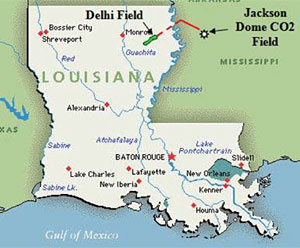
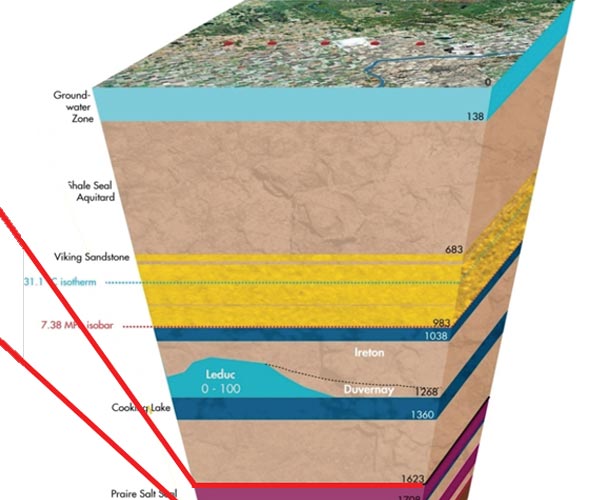

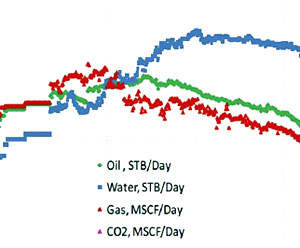






Join the Conversation
Interested in starting, or contributing to a conversation about an article or issue of the RECORDER? Join our CSEG LinkedIn Group.
Share This Article